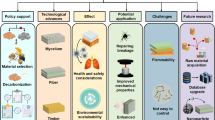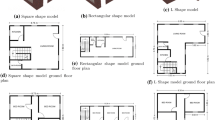Abstract
With increasing world population and economic development, the strain on resources is increasing. Energy consumption during construction and use of building is enormous. In this study, a quantitative comparison of various thermal insulation materials used in construction, from most commonly used to new, highly efficient insulation materials, was performed. It was demonstrated that the evaluation and consideration of environmental impact per unit weight of thermal insulation materials are inappropriate and can lead to misleading decisions, since it is imperative that the analysis considers the difference in the density of each thermal insulation material, as well as differences in their thermal conductivity. Furthermore, the environmental neutrality, i.e. the time needed to offset the carbon footprint of the manufacturing and the installation of thermal insulation materials in the building envelope with the difference between the carbon footprint of the heat losses in the heating season through a currently averagely insulated external envelope and a well-insulated external envelope, is achieved in very short-time periods. For the thermal insulation materials with the lowest environmental impact, it is reached in less than one heating season and soon after tenth heating seasons for the insulation with the highest environmental impact.



Similar content being viewed by others
Abbreviations
- CFC:
-
Chloro-fluoro-hydrocarbons
- EPS:
-
Expanded polystyrene
- GWP:
-
Global warming potential
- LCA :
-
Life cycle assessment/analysis
- LCCA:
-
Life cycle cost assessment
- LCI:
-
Life cycle inventory
- PU:
-
Polyurethane
- VIP :
-
Vacuum insulation panel
- XPS:
-
Extruded polystyrene
- CO2-eq:
-
CO2 equivalent
- U :
-
Thermal transmittance W/(m2 K)
- AHDD:
-
Annual heating degree days K day = 86,400 K sec
- R :
-
Thermal resistance (m2 K)/W
- ρ :
-
Density kg/m3
- λ :
-
Thermal conductivity W/(m K)
References
Adan, H., & Fuerst, F. (2016). Do energy efficiency measures really reduce household energy consumption? A difference-in-difference analysis. Energy Efficiency, Springler, 9(5), 1207–1219. doi:10.1007/s12053-015-9418-3.
Anastaselos, D., Oxizidis, S., & Papadopoulos, A. M. (2017). Suitable thermal insulation solutions for Mediterranean climatic conditions: a case study for four Greek cities. Energy Efficiency, Springer. doi:10.1007/s12053-016-9504-1.
ASHRAE Standards 90.1. (2004). Energy standard for buildings except low-rise residential buildings. Atlanta: American Society of Heating, Refrigerating and Air-Conditioning Engineers, Inc.
ASHRAE Standards 90.2. (2004). Energy efficient design of low-rise residential buildings. Atlanta: American Society of Heating, Refrigerating and Air-Conditioning Engineers, Inc.
Aste, N., Angelotti, A., & Buzzetti, M. (2009). The influence of the external walls thermal inertia on the energy performance of well insulated buildings. Energy and Buildings, 41(11), 1181–1187. doi:10.1016/j.enbuild.2009.06.005.
Berry, S., Davidson, K., & Saman, W. (2014). Defining zero carbon and zero energy homes from a performance-based regulatory perspective. Energy Efficiency, 7, 303–322.
Bribian, I. Z., Capilla, A. V., & Uson, A. A. (2011). Life cycle assessment of building materials: comparative analysis of energy and environmental impacts and evaluation of the eco-efficiency improvement potential. Building and Environment, 46, 1133–1140.
Buyle, M., Braet, J., Audenaert A. (2013). Life cycle assessment in the construction sector: a review, renewable and sustainable energy reviews, Elsevier, DOI: 10.1016/j.rser.2013.05.001.
Citherlet, S., & Defaux, T. (2007). Energy and environmental comparison of three variants of a single family house during its whole life span. Building and Environment, 42, 591–598.
Climate Change (2013). IPCC (Intergovernmental Panel on Climate), Accessed 21 September 2016.
Cuce, E., Cuce, P. M., Wood, C. J., & Riffat, S. B. (2014). Toward aerogel based thermal superinsulation in buildings: a comprehensive review. Renewable and Sustainable Energy Reviews. doi:10.1016/j.rser.2014.03.017.
Dikmen, N., & Ozkan, S. T. E. (2016). Unconventional insulation materials. Intech, Open Science, 3–23. doi:10.5772/63311.
Dovjak, M., Shukuya, M., & Krainer, A. (2012). Exergy analysis of conventional and low exergy systems for heating and cooling of near zero energy buildings. Journal of Mechanical Engineering, 58(7/8), 453–461.
Dylewski R., Adamczyk, J. (2014). Life cycle assessment (LCA) of building thermal insulation materials, Eco-efficient construction and building materials: life cycle assessment (LCA), eco-labelling and case studies, building materials—environmental aspects product life cycle—environmental aspects, Woodhead Publishing series in civil and structural engineering, Number 49, Oxford Woodhead Publishing, pp 267–286.
Ecoinvent database 3.1 (2014). Swiss Centre for Life Cycle Inventories, Dübendorf, Switzerland.
EN 15804 (2012). Sustainability of construction works–environment product declarations–core rules for the product category of construction products, European Standard.
EN ISO 13790 (2008). Energy performance of buildings—calculation of energy use for space heating and cooling. International Standards Organization, Geneva, Switzerland, European and ISO standard.
EN ISO 6946. (2008). Building components and building elements – Thermal resistance and thermal transmittance – Calculation method. Geneva: European and ISO standard.
Energy Plus Weather Data (2016). Energy plus documentation. Engineering Reference. https://energyplus.net/weather-location/europe_wmo_region_6/SVN, Accessed 21 September 2016.
EPBDr. (2010). Energy performance in building directive, Directive 2010/31/EC of the European Parliament and of the Council on the energy performance of buildings (recast). Official Journal of the European Union, L153, 1335.
Hudobivnik, B., Pajek, L., Kunič, R., & Košir, M. (2016). FEM thermal performance analysis of multi-layer external walls during typical summer conditions considering high intensity passive cooling. Applied Energy, 178, 363–375. doi:10.1016/j.apenergy.2016.06.036.
Hunt, R., Sellers, J., & Franklin, W. (1992). Resource and environmental profile analysis: a life cycle environmental assessment for products and procedures. Environmental Impact Assessment Review, 12, 245–269.
ISO 14040. (2006). Environmental management—Life cycle assessment—requirements and guidelines. Standard. Geneva: International Standards Organization.
Jelle, B. P. (2011). Traditional, state-of-the-art and future thermal building insulation materials and solutions—prosperities, requirements and possibilities. Energy and Building, Elsevier. doi:10.1016/j.enbuild.2011.05.015.
Korjenic, A., & Klarić, S. (2011). The revival of the traditional Bosnian wood dwellings. Energy Efficiency, Springer. doi:10.1007/s12053-011-9120-z.
Košir, M., Krainer, A., Dovjak, M., Perdan, R., & Kristl, Ž. (2010). Alternative to conventional heating and cooling systems in public buildings. Journal of Mechanical Engineering, 56(9), 575–583.
Kottek, M., Grieser, J., Beck, C., Rudolf, B., & Rubel, F. (2016). World map of the Köppen–Geiger climate classification updated. Meteorologische Zeitschrift, 15(3), 259–263. doi:10.1127/0941-2948/2006/0130 Accessed 21 September 2016.
Kunič, R. (2007). Planning an assessment of the impact of accelerated ageing of bituminous sheets on constructional complexes: doctoral thesis. Ljubljana.
Kunič, R., & Krainer, A. (2009). Economical thickness of thermal insulation layers in ETICS facade systems. Gradbeni Vestnik, 58(2), 306–311.
Kunič, R., & Krainer, A. (2010). Economical thickness of thermal insulation layers in flat roofs. Gradbeni Vestnik, 59(1), 6–12.
Lakrafli, H., Tahiri, S., El Houssaini, S., & Bouhria, M. (2017). Effect of thermal insulation using leather and carpentry wastes on thermal comfort and energy consumption in a residential building. Energy Efficiency, Springler. doi:10.1007/s12053-017-9513-8.
Martínez-Rocamora, A., Solís-Guzmán, J., & Marrero, M. (2016). LCA databases focused on construction materials: a review. Renewable and Sustainable Energy Reviews, 58, 565–573 ISSN 1364-0321.
Melo, de C. A., Jannuzzi G.M. (2015). Cost-effectiveness of CO2 emissions reduction through energy efficiency in Brasilian building sector. Energy Efficiency, Springer. doi:10.1007/s12053-014-9322-2.
Moran, P., Goggins, J., & Hajdukiewicz, M. (2017). Super-insulate or use renewable technology? Life cycle cost, energy and global warming potential analysis of nearly zero energy buildings (NZEB) in a temperature oceanic climate. Energy and Building, Elsevier. doi:10.1016/j.enbuild.2017.01.029.
Navarro, L., de Gracia, A., Castell, A., et al. (2015). Thermal behavior of insulation and phase change materials in buildings with internal heat loads: experimental study. Energy Efficiency, Springler, 8(5), 895–904. doi:10.1007/s12053-015-9330-x.
Nelson, W., Smith, M. G., Wanek, C. (2002). The Art of Natural Building Gabriola Island BC: New Society Publishers, 138–142.
Newsham, G. R., Mancini, S., & Birt, B. J. (2009). Do LEED-certified buildings save energy? Yes, but… Energy and Buildings, 41, 897–905.
Paganin, G., Angelotti, A., Ducoli, C., et al. (2017). Energy performance of an exhibition hall in a life cycle perspective: embodied energy, operational energy and retrofit strategies. Energy Efficiency, Springler, 1–22. doi:10.1007/s12053-017-9521-8.
PAS 2050 (2011). Specification for the assessment of the life cycle greenhouse gas emissions of goods and services.
Pearce, A., Makarand, H., Vanegas, J. (1995). A decision support system for construction materials selection using sustainability as a criterion. V: Proceedings of the 28th Annual Conference, National Conference of States on Building Codes and Standards. Albuquerque, November 1–4.
Pfundstein, M., Schulz, C., Gellert, R., Spitzner, M.H. (2008). Insulating materials. Munich: Institut für Internationale Architektur-Dokumentation.
Pohl, J. (2011). Building science: concepts and application. First. Chichester: Wiley-Blackwell.
PURES (2010). Rules on efficient use of energy in buildings, Official Journal of the republic of Slovenia, No. 52/2010, XX, 7840–7847. TSG-1-004: technical guidelines for efficient energy use in buildings, 1st edition.
Rietbergen, M. G., Opstelten, I. J., & Blok, K. (2017). Improving energy and carbon management in construction and civil engineering companies—evaluating the impacts of the CO2 Performance Ladder. Energy Efficiency, Springler, 10(1), 55–79. doi:10.1007/s12053-016-9436-9.
Roberts, D.V. (1994). Sustainable development—a challenge for the engineering profession. The role of engineering in sustainable development. American Association of Engineering Societies, Washington DC: 44–61.
Ruá, M. J., & Guadalajara, N. (2015). Estimating a threshold price for CO2 emissions of buildings to improve their energy performance level: case study of a new Spanish home. Energy Efficiency, Springler, 8(2), 183–203. doi:10.1007/s12053-014-9286-2.
SETAC. (1991). A technical framework for life cycle assessment. Washington, DC: SETAC, USA, Guidelines for life cycle assessments: a code of practice. Brussels: SETAC, Europe; (1993).
Silvestre, J. D., de Brito, J., & Pinheiro, M. D. (2013). From the new European Standards to an environmental, energy and economic assessment of building assemblies from cradle-to-cradle (3E-C2C). Energy and Buildings, Springler, 64, 199–208. doi:10.1016/j.enbuild.2013.05.001.
Simapro v7.1 (2009). SimaPro Analyst Indefinite, version 7.1, Product Ecology Consultants, PEC, the Netherlands, www.pre.nl/default.htm.
Skodras, G., Grammelis, P., Kakaras, E., & Sakellaropoulus, G. P. (2014). Evaluation of the environmental impact of waste wood co-utilisation for energy production. Energy Efficiency, Springler. doi:10.1016/j.energy.2004.03.017.
Špeglej, T., Premrov, M., & Žegarac, L. V. (2016). Development ot the timber-glass upgrade module for the purpose of its installation on energy-inefficient buildings in the refurbishment process. Energy Efficiency, Springer. doi:10.1007/s12053-016-9494-z.
STAT. (2012), www.stat.si. Statistical Office of the Republic of Slovenia. Accessed 25 June 2012.
Stazi, F., Bonfigli, C., Tomassoni, E., Di Perna, C., & Munafò, P. (2015). The effect of high thermal insulation on high thermal mass: is the dynamic behaviour of traditional envelopes in Mediterranean climates still possible? Energy and Buildings, 88, 367–383. doi:10.1016/j.enbuild.2014.11.056.
Stazi, F., Tomassoni, E., Bonfigli, C., & Di Perna, C. (2014). Energy, comfort and environmental assessment of different building envelope techniques in a Mediterranean climate with a hot dry summer. Applied Energy, Elsevier. doi:10.1016/j.apenergy.2014.08.023.
Stazi F, Tomassoni E, Di Perna C. (2016). Super-insulated wooden envelopes in Mediterranean climate: summer overheating, thermal comfort optimization, environmental impact on an Italian case study. Energy Build In Press, Accepted Manuscript. doi:10.1016/j.enbuild.2016.12.042.
Takano, A., Hughes, M., & Winter, S. (2014). A multidisciplinary approach to sustainable building material selection: a case study in a Finnish context. Building and Environment, 82, 526–535.
Vattenfall (2015), www.vattenfall.com. Accessed 25 January 2015.
Vilches, A., Garcia-Martinez, A., & Sanchez-Montañes, B. (2016). Life cycle assessment (LCA) of building refurbishment: a literature review. Energy and Building, Elseviera. doi:10.1016/j.enbuild.2016.11.042.
Zabalza, I., Aranda, A., Scarpellini, S., Diaz, S. (2009). Life cycle assessment in building sector: state of the art and assessment of environmental impact for building materials, 1st International Exergy, Life Cycle Assessment and Sustainability Workshop & Symposium (ELCAS), Nisyros, Greece.
Acknowledgements
This work was supported by the Slovenian Research Agency (Programme P2-0158), and by the European Regional Development Found, Research and development programmes (TRL 3-6), sustainable and innovative construction of smart buildings (smart buildings and home, including wood chain: TIGR4smart) (Programme C3330-16-529003).
Many thanks to the anonymous reviewers for their assistance in improving the quality and originality of the manuscript.
Author information
Authors and Affiliations
Corresponding author
Ethics declarations
Conflict of interest
The author declares that he does not have any conflict of interest.
Rights and permissions
About this article
Cite this article
Kunič, R. Carbon footprint of thermal insulation materials in building envelopes. Energy Efficiency 10, 1511–1528 (2017). https://doi.org/10.1007/s12053-017-9536-1
Received:
Accepted:
Published:
Issue Date:
DOI: https://doi.org/10.1007/s12053-017-9536-1




